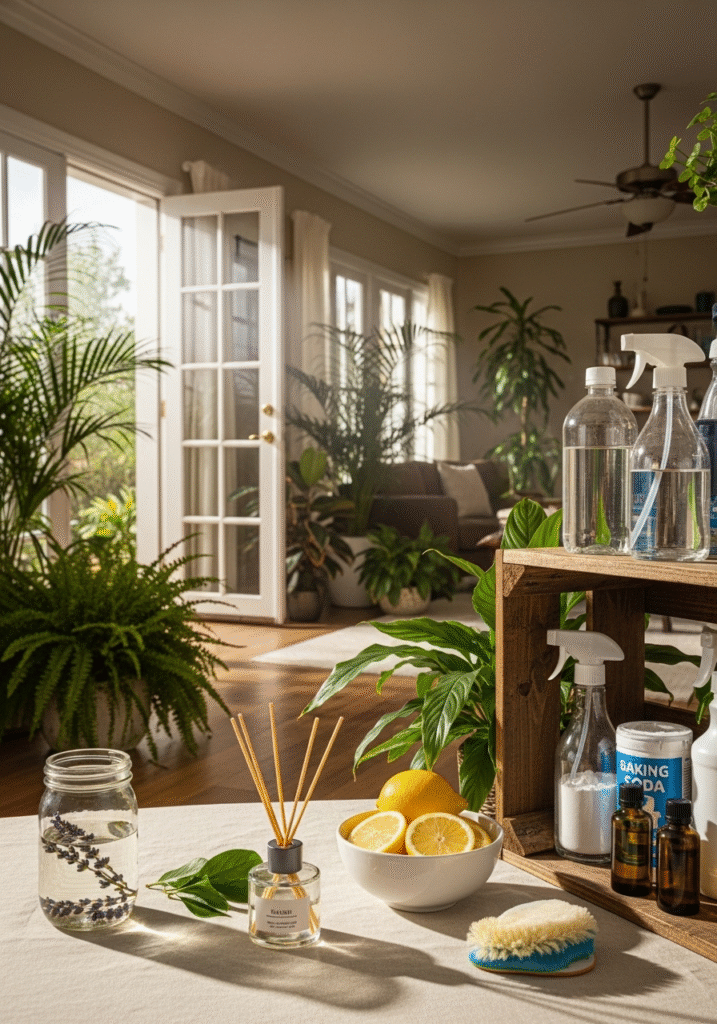A clean and fresh-smelling home is not just pleasant to live in—it also reflects a sense of well-being, comfort, and care. Yet many of the commercial products we turn to for that clean scent—such as air fresheners, sprays, and even some cleaning agents—are filled with synthetic chemicals that can pose risks to both human health and the environment. These products may emit volatile organic compounds (VOCs), contribute to indoor air pollution, and trigger allergies or respiratory issues, especially in children, pets, and those with sensitivities.
Fortunately, you don’t need to rely on artificial fragrances or chemical-laden cleaners to enjoy a welcoming and fragrant living space. Nature offers a wide range of safe, effective, and affordable alternatives that can help purify the air and infuse your home with pleasant aromas. From DIY air fresheners made with essential oils to naturally absorbent materials like baking soda and activated charcoal, there are countless eco-friendly strategies that not only freshen your home but also align with a more sustainable lifestyle.
In this comprehensive guide, we explore a variety of natural methods to maintain a clean and inviting indoor environment. You’ll learn how to harness the power of simple, everyday ingredients to eliminate odors, discover houseplants that naturally purify the air, create your own chemical-free cleaning products, and incorporate essential oils for long-lasting freshness. Whether you live in a small apartment or a large family home, these techniques are designed to be easy, affordable, and environmentally responsible.
By choosing natural solutions, you’re not only protecting your own health and that of your loved ones—you’re also reducing your ecological footprint and contributing to a healthier planet. Let’s explore how to keep your home smelling fresh the natural way—without compromising on cleanliness, safety, or sustainability
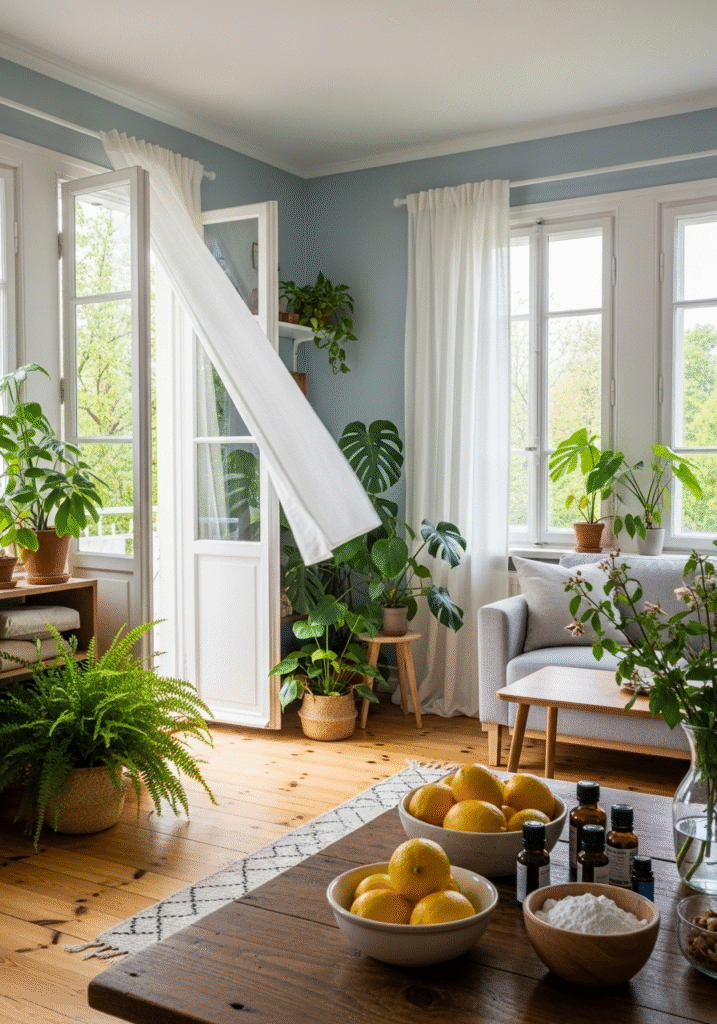
Why Natural Solutions Are Better
In today’s world, many households rely on commercial air fresheners and cleaning products to create a pleasant-smelling, clean environment. These products promise instant freshness, but what often goes unnoticed are the hidden health and environmental risks that come with them. Most conventional air fresheners work by masking odors rather than eliminating them, and they frequently contain synthetic fragrances, aerosol propellants, and other chemical additives. When used indoors, these substances can release volatile organic compounds (VOCs)—gases that are emitted into the air and may have adverse short- and long-term health effects.
Exposure to VOCs and other synthetic chemicals has been linked to a variety of health issues. These include headaches, dizziness, allergic reactions, eye and throat irritation, respiratory problems, and even more serious conditions such as hormonal disruptions or long-term damage to organs with extended exposure. Vulnerable groups such as children, pregnant women, elderly individuals, and people with asthma or chemical sensitivities are particularly at risk. Furthermore, many of these substances contribute to indoor air pollution, which can be up to five times more polluted than outdoor air, according to environmental studies.
Natural solutions offer a safer, healthier alternative. Derived from plant-based ingredients, essential oils, herbs, and common household items like vinegar and baking soda, these methods effectively neutralize odors rather than cover them up. They not only improve the air quality in your home but also reduce your exposure to toxic substances. Moreover, natural alternatives tend to be more cost-effective in the long run. Simple DIY recipes using ingredients you already have at home can replace multiple commercial products, saving you money while reducing waste.
Another compelling reason to choose natural options is their eco-friendliness. Many commercial air fresheners are packaged in plastic or aerosol containers, contributing to environmental pollution. On the other hand, using reusable containers, refillable diffusers, or biodegradable materials minimizes environmental impact. By embracing natural methods, you’re not just making your home a safer and more pleasant place to live—you’re also making a conscious choice to reduce your carbon footprint and support a more sustainable way of living.
In essence, natural solutions are better because they are healthier, more economical, and environmentally responsible. They offer a holistic approach to home care, promoting both personal wellness and ecological balance. With growing awareness about the harmful effects of synthetic chemicals, more people are turning to natural alternatives—and finding that they’re not only effective
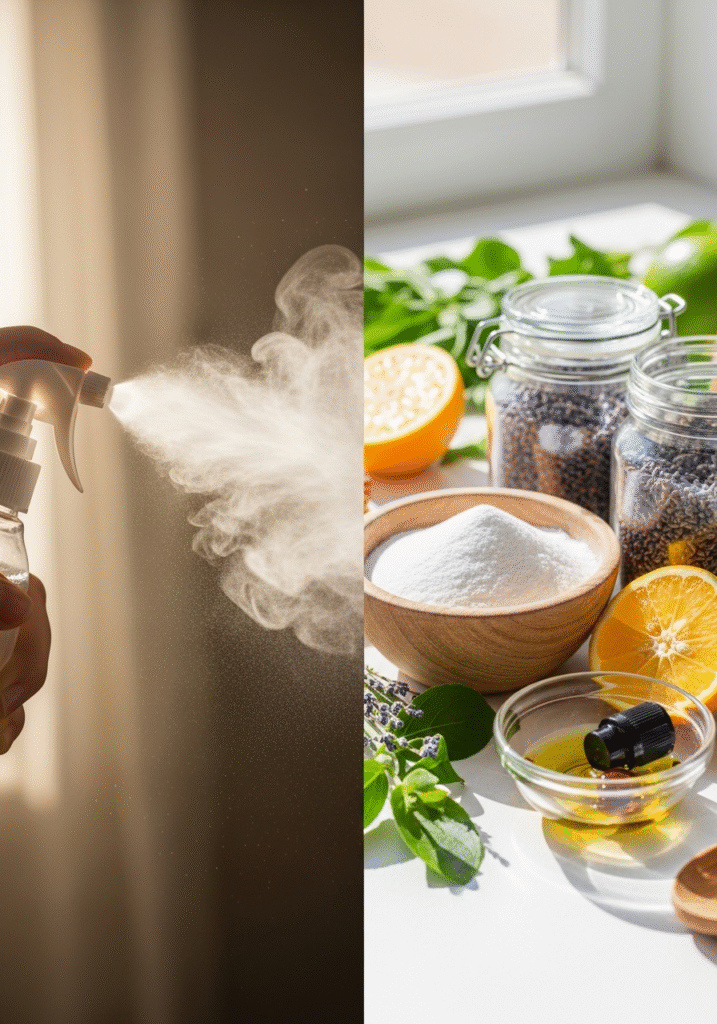
Identify and Eliminate Odor Sources
Before you introduce any natural fragrance into your living space, it’s essential to first identify and eliminate the root causes of unpleasant odors. Simply covering up bad smells with air fresheners, even natural ones, is not an effective long-term solution. A clean, neutral-smelling home provides the best foundation for fresh scents to truly shine—and that starts with locating where odors originate and addressing them directly.
Check Sinks and Drains
Kitchen and bathroom drains are common culprits of foul indoor odors. Over time, bits of food, grease, hair, and soap residue can build up inside pipes and begin to decompose, emitting a sour or musty smell. If left untreated, these odors can quickly spread through the kitchen or bathroom.
- Natural Solution: Pour half a cup of baking soda down the drain, followed by one cup of white vinegar. Allow the mixture to fizz and sit for 10–15 minutes. Then flush the drain with a pot of hot water to rinse away loosened residue. This combination not only neutralizes odors but also helps break down mild clogs.
- Pro Tip: Use this method once a week to maintain odor-free drains, especially in high-use areas like the kitchen.
Inspect Trash Bins
Even if you take the trash out regularly, residual waste, leaks, and food particles in the bottom of the bin can create persistent odors. In warm, humid environments, bacteria can multiply quickly, intensifying the smell.
- Natural Solution: Empty trash bins frequently, and once a week, wash them out using a solution of warm water, white vinegar, and a few drops of tea tree or lemon essential oil for natural antibacterial and deodorizing power. Allow the bins to air-dry thoroughly before adding a new liner.
- Pro Tip: Sprinkle baking soda or place a small charcoal deodorizer at the bottom of the bin to absorb odors between cleanings.
Look for Mold and Mildew
Mold and mildew not only smell musty and unpleasant—they can also be hazardous to your health. These fungi thrive in damp, dark, and poorly ventilated areas such as bathrooms, basements, behind furniture, or under sinks. If you detect a persistent earthy or sour smell, it may be due to hidden mold growth.
- Natural Solution: Spray visible mold and mildew with white vinegar or 3% hydrogen peroxide. Let the solution sit for 10–15 minutes before scrubbing with a brush. Avoid mixing these two substances together, and never combine hydrogen peroxide with vinegar in the same container.
- Pro Tip: Use a dehumidifier or moisture-absorbing materials (like baking soda, charcoal, or silica gel) in areas prone to dampness to prevent future mold growth.
Improve Ventilation
Sometimes, bad odors aren’t due to a specific source—they’re simply the result of stagnant air. Poorly ventilated spaces trap moisture, cooking smells, pet odors, and general household activity, leading to a stale, musty environment. Good airflow is one of the most important—and most overlooked—factors in keeping a home smelling fresh.
- Natural Solution: Open windows and doors regularly to let fresh air circulate throughout your home. Use ceiling fans or portable fans to help air move more freely, especially in rooms without windows.
- Pro Tip: Install window screens so you can safely open windows without letting in insects. On pleasant days, consider leaving windows open for 30–60 minutes to allow natural cross-ventilation.
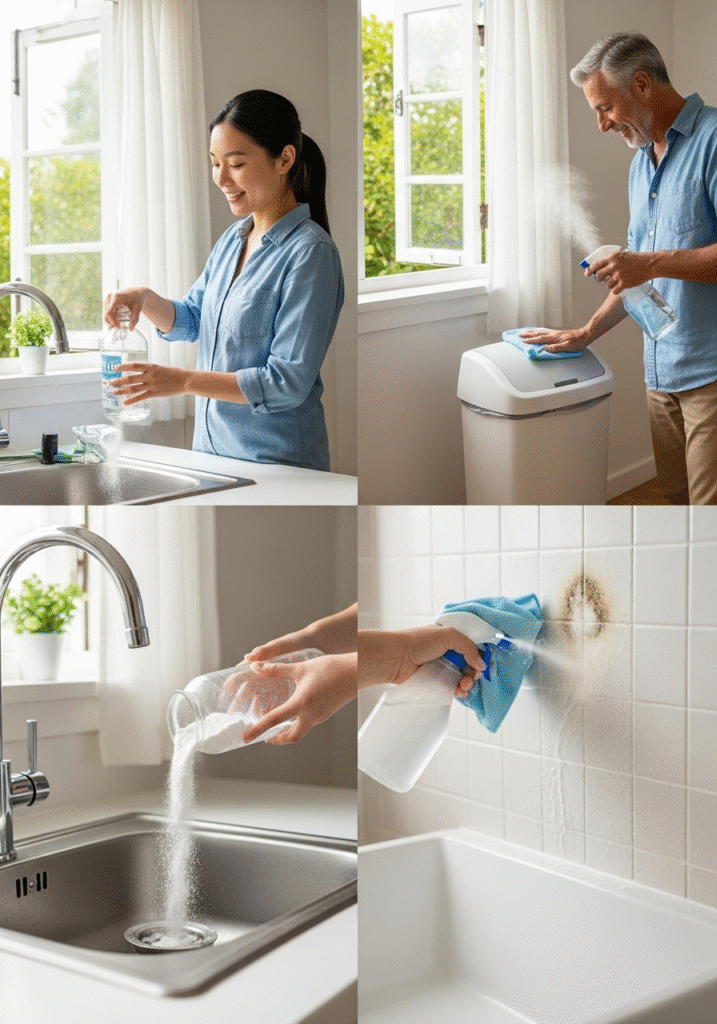
Natural Air Fresheners You Can Make at Home
DIY Scent Jars
Once you’ve removed unpleasant odors at their source, it’s time to introduce gentle, natural scents that make your home feel welcoming, comforting, and clean. Instead of relying on synthetic sprays or plug-ins that may contain harmful chemicals, you can craft your own DIY natural air fresheners using simple, non-toxic ingredients. These homemade options are not only safer for your health and the environment—they’re also budget-friendly, customizable, and surprisingly easy to make.
Here are three highly effective and versatile methods to naturally freshen your home:
DIY Scent Jars
Scent jars are a wonderful, low-maintenance way to keep small spaces like bathrooms, closets, entryways, or even car interiors smelling fresh around the clock. They’re reusable, customizable, and take just minutes to create.
How to Make:
- Take a small mason jar or glass container.
- Fill it halfway with baking soda, which naturally absorbs and neutralizes odors.
- Add 8–12 drops of your favorite essential oil—such as lavender, lemon, eucalyptus, or cinnamon.
- Cover the opening with a piece of breathable fabric, mesh, or cheesecloth, and secure it with a rubber band or screw-on ring (without the lid disc).
Why It Works:
The baking soda absorbs unwanted odors from the air, while the essential oil slowly releases its scent over time. You can refresh the aroma by stirring the mixture every few days or adding a few more drops of essential oil as needed.
Pro Tip: Use seasonal scents (like pine or peppermint in winter, citrus in summer) to create an ever-changing, cozy atmosphere in your home.
Simmer Pots
Simmer pots are a natural and aromatic way to infuse your home with beautiful, rich scents using ingredients you likely already have in your kitchen. They’re ideal for special occasions or cozy afternoons at home.
How to Make:
- Fill a pot with water and place it on the stove.
- Add a combination of fruits, herbs, and spices such as:
- Orange or lemon peels
- Cinnamon sticks
- Whole cloves
- Star anise
- Fresh rosemary or thyme
- Vanilla extract
- Bring the mixture to a gentle boil, then reduce to a simmer and let the fragrance waft through your home.
Why It Works:
As the water simmers, the natural oils and essences from the fruits and spices are released into the air, providing a comforting and inviting aroma without any synthetic ingredients.
Pro Tip: Keep an eye on the water level and add more as needed to avoid burning the ingredients. You can reuse the mixture for a couple of days if stored in the fridge between uses.
Essential Oil Diffusers
Essential oils are one of the most effective natural fragrance options and come in a wide variety of scents to suit every mood or purpose—whether you’re looking to relax, energize, or purify the air. Diffusers are a convenient, stylish way to enjoy the benefits of essential oils throughout the day.
Types of Diffusers:
- Ultrasonic Electric Diffusers: Use water and ultrasonic waves to disperse a cool mist of essential oils into the air.
- Reed Diffusers: Consist of a glass bottle filled with a carrier oil and essential oil blend. Reeds placed in the bottle soak up the mixture and slowly release the scent into the room.
Popular Essential Oils and Their Benefits:
- Lavender – Calming and great for bedrooms or relaxation spaces.
- Peppermint – Invigorating and refreshing, ideal for workspaces.
- Lemon or Orange – Bright and clean, perfect for kitchens or bathrooms.
- Eucalyptus – Purifying and uplifting, excellent for improving air quality.
Why It Works:
Essential oils are plant-based and contain natural aromatic compounds that not only smell good but often offer therapeutic benefits. Unlike synthetic fragrances, they can help support wellness while also keeping your environment smelling fresh.
Pro Tip: Try blending oils for a unique scent—like lavender and lemon for a fresh yet calming combination, or orange and clove for a warm, spicy aroma
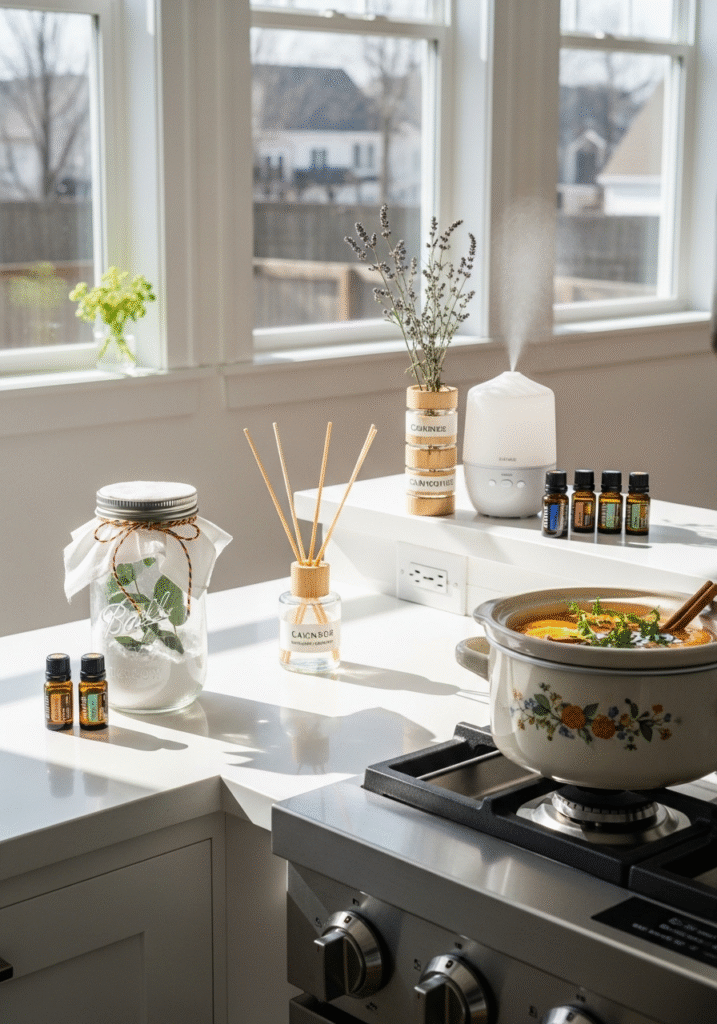
Best Houseplants for Fresh Air
Nature provides one of the most effective and aesthetically pleasing tools for improving indoor air quality: houseplants. Beyond their beauty, houseplants offer powerful air-purifying benefits that help neutralize odors, absorb toxins, and add a touch of serenity to your living space. Unlike artificial air fresheners that simply mask smells, many common indoor plants act as natural filters—removing harmful substances from the air while simultaneously increasing oxygen levels and humidity.
According to studies by NASA and other environmental health researchers, certain plants are particularly good at removing indoor air pollutants like formaldehyde, benzene, carbon monoxide, and mold spores. Here are some of the best houseplants you can introduce to your home to keep the air clean, fresh, and health-promoting:
1. Spider Plant (Chlorophytum comosum)
The spider plant is one of the most resilient and effective air-purifying houseplants. Its long, arching green leaves with white stripes make it an attractive addition to any room.
- Air Benefits: Known to absorb odors, smoke, and pollutants like formaldehyde and carbon monoxide.
- Maintenance: Thrives in bright, indirect light but is tolerant of low light. Water it moderately and avoid overwatering.
- Ideal Locations: Kitchens, living rooms, or near windows where it can get light without direct sun.
Bonus: It’s non-toxic to pets and produces “pups” or baby plants that you can replant or gift.
2. Peace Lily (Spathiphyllum)
The Peace Lily is both elegant and powerful. With its broad, deep green leaves and striking white flowers, it adds beauty while working hard to clean the air.
- Air Benefits: Removes mold spores, benzene, trichloroethylene, and formaldehyde. Also helps reduce airborne microbes.
- Maintenance: Prefers low to medium light and needs regular watering, but it’s forgiving if you occasionally forget.
- Ideal Locations: Bathrooms, laundry rooms, or other humid areas where mold spores may be present.
Bonus: Peace Lilies also increase humidity levels, which can be especially beneficial during dry seasons.
3. Aloe Vera (Aloe barbadensis miller)
Best known for its soothing gel used in skincare, Aloe Vera is also a wonderful plant for indoor air purification.
- Air Benefits: Absorbs formaldehyde and benzene, commonly found in household cleaners and paints.
- Maintenance: Needs bright, indirect sunlight and infrequent watering. It prefers to dry out completely between waterings, making it ideal for beginners or forgetful plant owners.
- Ideal Locations: Sun-drenched spots like kitchen windowsills or sunny living rooms.
Bonus: You can harvest the gel from the leaves to use for minor burns, cuts, or dry skin—a great dual-purpose plant.
4. English Ivy (Hedera helix)
English Ivy is a fast-growing climber that’s particularly helpful in targeting airborne mold, making it a top choice for improving air quality in damp or musty rooms.
- Air Benefits: Removes mold spores and airborne fecal particles. Great for allergy and asthma sufferers.
- Maintenance: Prefers moderate sunlight and evenly moist soil. Can be trained to climb or placed in hanging baskets to cascade gracefully.
- Ideal Locations: Bathrooms, basements, or near entryways where mold and mildew are more likely to thrive.
Caution: English Ivy is toxic to pets if ingested, so keep it out of reach of cats and dogs.
Tips for Maximizing the Benefits of Houseplants
- Place plants strategically in high-traffic areas, bedrooms, bathrooms, or near sources of odors.
- Wipe dust off leaves regularly so they can better absorb pollutants and light.
- Rotate plants every few weeks so all sides get equal exposure to light.
- Avoid overwatering, as excess moisture can lead to moldy soil—which defeats the purpose of using them to purify your home.
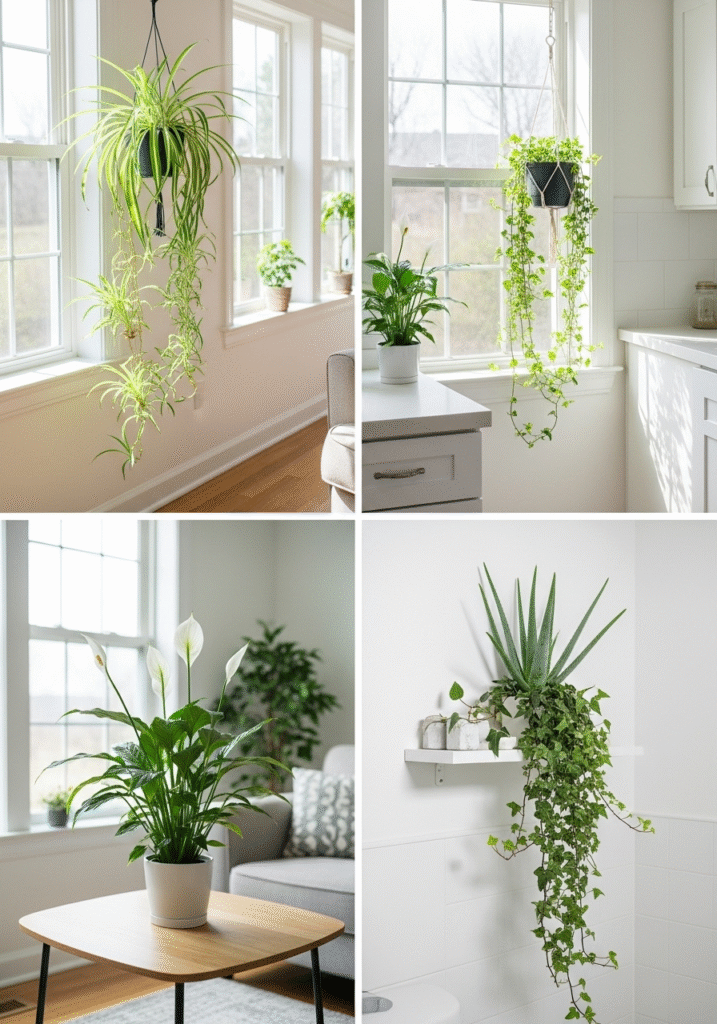
Deep Cleaning Tips for a Naturally Fresh Home
5. Deep Cleaning Tips for a Naturally Fresh Home
While daily tidying helps keep your home manageable, nothing beats a thorough deep clean for achieving a truly fresh, healthy indoor environment. Deep cleaning doesn’t just remove visible dirt—it targets the hidden grime, bacteria, and odors that accumulate over time in carpets, corners, upholstery, and less-used spaces. And best of all, you can achieve this level of clean without harsh chemicals by using a few trusted, natural ingredients.
Here’s how to harness the power of baking soda, white vinegar, and lemon juice to transform your home into a naturally clean and wonderfully fresh space.
Baking Soda: The Natural Deodorizer and Scrubber
Baking soda is a staple in natural cleaning thanks to its ability to absorb odors, cut through grease, and gently scrub surfaces without scratching. It’s ideal for deodorizing carpets, soft furnishings, and kitchen or bathroom surfaces.
How to Use:
- Carpets and Rugs: Sprinkle baking soda generously over carpets. Let it sit for 15–30 minutes (or overnight for stronger odors), then vacuum thoroughly. This lifts trapped odors and refreshes fibers.
- Upholstery and Mattresses: Lightly dust baking soda over couches, chairs, or mattresses, wait 30 minutes, then vacuum with an upholstery attachment.
- Kitchen/Bathroom Sinks and Tubs: Combine baking soda with a little water or white vinegar to form a paste. Scrub away soap scum, stains, and lingering smells naturally.
Pro Tip: For extra scent, mix baking soda with a few drops of essential oil before applying.
White Vinegar: A Natural Disinfectant and Odor Neutralizer
White vinegar is an excellent, non-toxic multipurpose cleaner that helps kill bacteria, cut through soap scum, and dissolve mineral deposits. Despite its sharp smell, vinegar neutralizes bad odors rather than masking them—and its scent fades quickly, leaving your home smelling clean.
How to Use:
- Floors: Mix 1 cup of vinegar with 1 gallon of warm water for a safe, streak-free way to clean tile, linoleum, or sealed wood floors.
- Windows and Mirrors: Combine equal parts white vinegar and water in a spray bottle. Spray on glass and wipe with a microfiber cloth for a streak-free shine.
- Bathrooms: Spray straight vinegar (or a 1:1 vinegar and water mix) on tiles, tubs, toilet bowls, and shower doors. Let it sit to dissolve soap scum and disinfect surfaces.
Pro Tip: If the vinegar smell is too strong, infuse it with citrus peels (like orange or lemon) for a few days before use.
Lemon Juice: Fresh, Antibacterial, and Brightening
Lemon juice brings natural antibacterial properties, a clean, bright scent, and gentle bleaching power to your cleaning routine. It’s especially useful for cutting through grease, removing stains, and adding a fresh citrus aroma to kitchens and bathrooms.
How to Use:
- Kitchen Counters and Cutting Boards: Rub lemon juice over surfaces to disinfect and deodorize. It’s especially useful on wooden cutting boards.
- Microwave Refresh: Place sliced lemons in a bowl of water and microwave for 3–5 minutes. The steam loosens grime while the lemon eliminates odors.
- Sink Shine: Use lemon juice and baking soda together to scrub sinks until they sparkle.
Pro Tip: Mix lemon juice with white vinegar for a powerful all-purpose cleaner with a pleasant citrus scent.
Establishing a Natural Deep-Cleaning Routine
To keep your home consistently fresh, it’s important to follow a regular cleaning schedule based on how each space is used:
- High-traffic areas like kitchens, bathrooms, living rooms, and entryways should be deep cleaned weekly. These are the spaces where odors and grime build up most quickly.
- Less-used spaces like guest rooms, home offices, and closets can be deep cleaned monthly. Even if they seem tidy, dust and stale air can collect over time.
- Don’t forget “hidden” zones like baseboards, ceiling fans, behind furniture, and inside appliances (like your fridge, dishwasher, or washing machine). These areas often harbor unnoticed smells and bacteria.
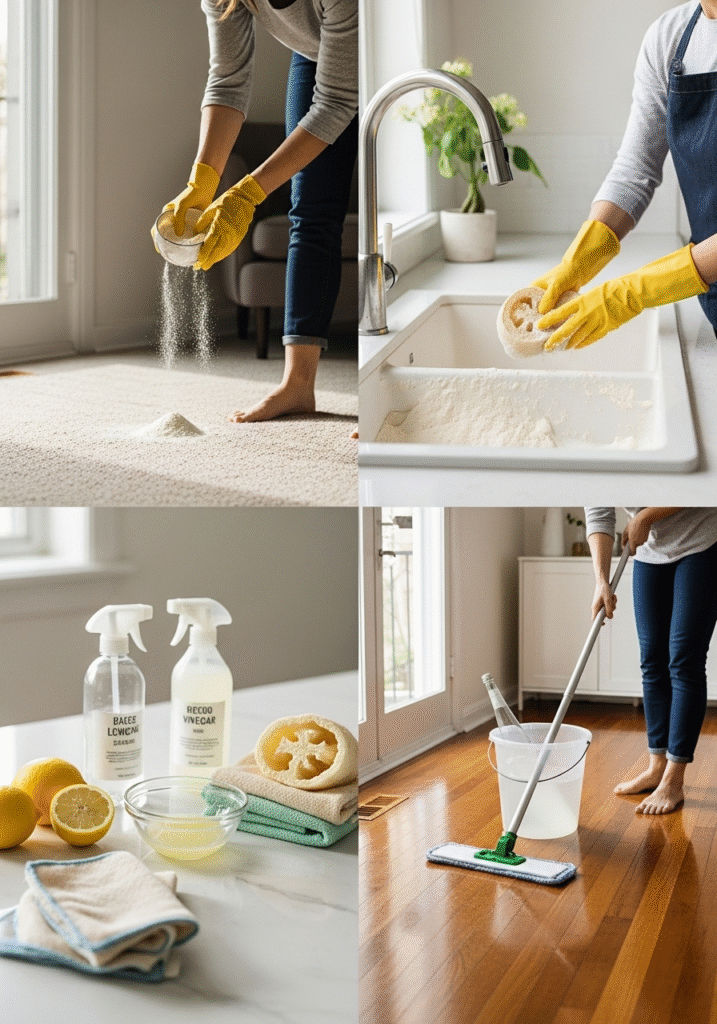
Natural Fabric Refreshers and Linen Sprays
Even when your home is clean and tidy, fabrics like curtains, bedding, throw pillows, and upholstered furniture can subtly hold onto odors—from cooking, pets, or daily use. While commercial fabric sprays may seem like a quick fix, they often contain artificial fragrances and chemicals that can trigger allergies, irritate sensitive skin, or degrade air quality over time.
The good news? You can make your own natural fabric refreshers and linen sprays at home using safe, gentle ingredients that not only smell amazing but are better for your health and the environment. These sprays are easy to make, highly customizable, and cost-effective—perfect for anyone seeking a naturally fresh-smelling home.
Why Use Natural Fabric Refreshers?
- No synthetic fragrances or aerosols
Many commercial sprays contain phthalates and other VOCs (volatile organic compounds) that may linger in the air and on your fabrics. Natural sprays eliminate this risk. - Gentle on skin and lungs
Homemade sprays using essential oils are less likely to cause irritation and are safe to use around children and pets (depending on oil selection). - Customizable scents for mood and season
You control the scent—opt for calming lavender for the bedroom, energizing citrus for living areas, or refreshing eucalyptus for bathroom linens. - Cost-effective and eco-friendly
A few simple, natural ingredients can replace multiple store-bought products, cutting down on both cost and packaging waste.
DIY Linen Spray Recipe
This easy-to-make spray is ideal for spritzing on bedding, curtains, throw blankets, and even in the air as a light room refresher.
Ingredients:
- 1 cup distilled water – Helps preserve freshness and prevents mineral residue.
- 2 tablespoons witch hazel or vodka – Acts as a natural preservative and helps the essential oils mix evenly with the water.
- 10–15 drops of essential oil – Choose oils based on scent preference and purpose (e.g., lavender for relaxation, lemon for freshness, peppermint for clarity).
Instructions:
- Add the distilled water and witch hazel (or vodka) into a clean spray bottle.
- Add 10–15 drops of your favorite essential oil or a blend (see suggestions below).
- Secure the lid and shake well to mix the ingredients.
- Shake before each use, and lightly mist fabrics from about 8–10 inches away.
Storage Tip: Store your spray in a dark-colored glass bottle to help preserve the essential oils, and keep it in a cool place away from direct sunlight.
Suggested Essential Oil Combinations
- Relaxing Blend: Lavender + Chamomile (perfect for pillows and bedding)
- Fresh & Clean: Lemon + Tea Tree + Rosemary (great for bathroom towels and curtains)
- Uplifting Citrus: Orange + Grapefruit + Mint (ideal for living room furniture or car seats)
- Herbal Calm: Eucalyptus + Lavender + Sage (soothing and purifying)
Where to Use Your Natural Fabric Refresher
- Curtains and Drapes: Mist lightly to freshen up without needing to wash.
- Bedding and Pillows: Use before bed for a relaxing scent or after making the bed for a clean, welcoming touch.
- Upholstered Furniture: Refresh sofas, armchairs, and ottomans—especially those in high-traffic areas.
- Closets and Drawers: Spray lightly on hanging clothes or inside drawers to prevent musty smells.
- Car Interiors: A few spritzes on cloth seats or floor mats will give your vehicle a natural, non-toxic scent boost.
Safety Tips
Even when your home is clean and tidy, fabrics like curtains, bedding, throw pillows, and upholstered furniture can subtly hold onto odors—from cooking, pets, or daily use. While commercial fabric sprays may seem like a quick fix, they often contain artificial fragrances and chemicals that can trigger allergies, irritate sensitive skin, or degrade air quality over time.
The good news? You can make your own natural fabric refreshers and linen sprays at home using safe, gentle ingredients that not only smell amazing but are better for your health and the environment. These sprays are easy to make, highly customizable, and cost-effective—perfect for anyone seeking a naturally fresh-smelling home.
Why Use Natural Fabric Refreshers?
- No synthetic fragrances or aerosols
Many commercial sprays contain phthalates and other VOCs (volatile organic compounds) that may linger in the air and on your fabrics. Natural sprays eliminate this risk. - Gentle on skin and lungs
Homemade sprays using essential oils are less likely to cause irritation and are safe to use around children and pets (depending on oil selection). - Customizable scents for mood and season
You control the scent—opt for calming lavender for the bedroom, energizing citrus for living areas, or refreshing eucalyptus for bathroom linens. - Cost-effective and eco-friendly
A few simple, natural ingredients can replace multiple store-bought products, cutting down on both cost and packaging waste.
DIY Linen Spray Recipe
This easy-to-make spray is ideal for spritzing on bedding, curtains, throw blankets, and even in the air as a light room refresher.
Ingredients:
- 1 cup distilled water – Helps preserve freshness and prevents mineral residue.
- 2 tablespoons witch hazel or vodka – Acts as a natural preservative and helps the essential oils mix evenly with the water.
- 10–15 drops of essential oil – Choose oils based on scent preference and purpose (e.g., lavender for relaxation, lemon for freshness, peppermint for clarity).
Instructions:
- Add the distilled water and witch hazel (or vodka) into a clean spray bottle.
- Add 10–15 drops of your favorite essential oil or a blend (see suggestions below).
- Secure the lid and shake well to mix the ingredients.
- Shake before each use, and lightly mist fabrics from about 8–10 inches away.
Storage Tip: Store your spray in a dark-colored glass bottle to help preserve the essential oils, and keep it in a cool place away from direct sunlight.
Suggested Essential Oil Combinations
- Relaxing Blend: Lavender + Chamomile (perfect for pillows and bedding)
- Fresh & Clean: Lemon + Tea Tree + Rosemary (great for bathroom towels and curtains)
- Uplifting Citrus: Orange + Grapefruit + Mint (ideal for living room furniture or car seats)
- Herbal Calm: Eucalyptus + Lavender + Sage (soothing and purifying)
Where to Use Your Natural Fabric Refresher
- Curtains and Drapes: Mist lightly to freshen up without needing to wash.
- Bedding and Pillows: Use before bed for a relaxing scent or after making the bed for a clean, welcoming touch.
- Upholstered Furniture: Refresh sofas, armchairs, and ottomans—especially those in high-traffic areas.
- Closets and Drawers: Spray lightly on hanging clothes or inside drawers to prevent musty smells.
- Car Interiors: A few spritzes on cloth seats or floor mats will give your vehicle a natural, non-toxic scent boost.
Safety Tips
- Always test on a small, hidden patch of fabric before spraying more broadly to ensure there is no staining or reaction.
- Be mindful of essential oil selection around pets, especially cats and dogs. Oils like tea tree, eucalyptus, and citrus can be harmful in high concentrations.
- Shake the bottle before each use, as oils may settle.
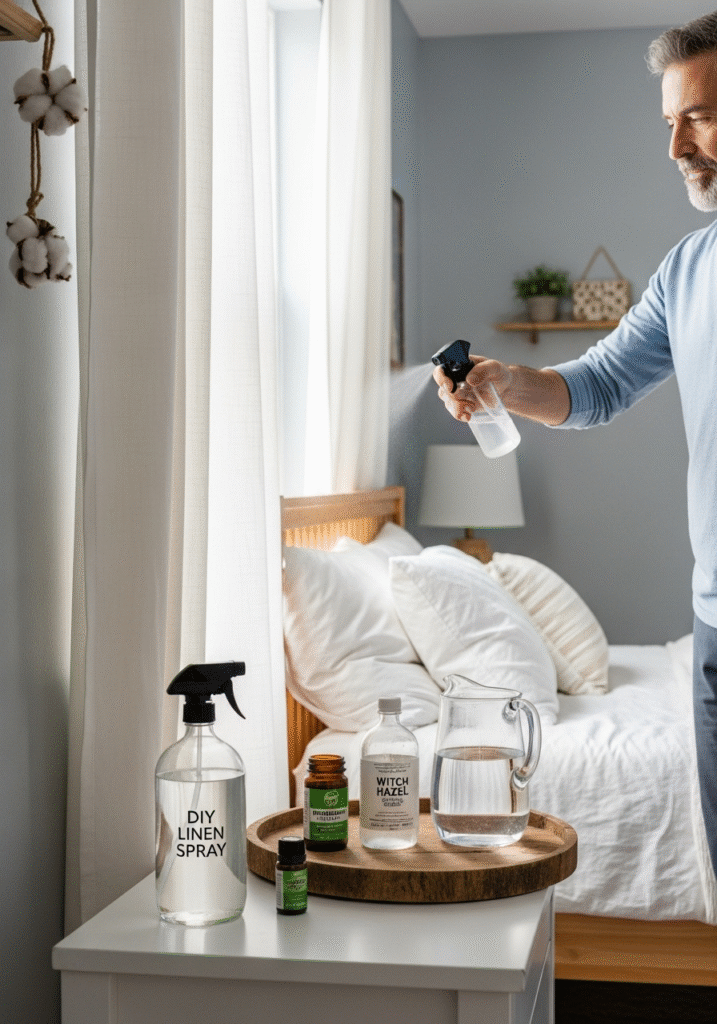
Kitchen Odor Control Hacks
The kitchen is often the most active and aromatic room in the house—filled with the delicious smells of cooking, but also with strong, lingering odors that can quickly become unpleasant. From frying fish to chopping onions or storing leftovers, it’s easy for odors to cling to surfaces, fabrics, and the air itself. Fortunately, you don’t need synthetic air fresheners or heavy-duty chemical sprays to keep your kitchen smelling clean and pleasant.
With a few simple and natural tricks—most of which involve ingredients you likely already have—you can neutralize odors at the source and leave your kitchen feeling light, fresh, and welcoming. Here’s how:
1. Boil Lemon Slices to Neutralize Cooking Odors
Citrus fruits, especially lemons, have natural antibacterial and deodorizing properties. When simmered in water, lemons release oils and vapors that help cut through strong odors like garlic, onion, or grease. The fresh citrus steam fills your kitchen with a clean, zesty scent while also acting as a mild natural humidifier.
How to Use:
- Slice one or two lemons and place them in a pot of water.
- Bring the water to a gentle boil, then reduce to a simmer.
- Let it simmer for 20–30 minutes while you’re cleaning up or after cooking a particularly aromatic meal.
Optional Add-ins: You can enhance the aroma by adding a few sprigs of rosemary, a couple of cinnamon sticks, or cloves for a spicy, herbal twist.
2. Use Coffee Grounds to Absorb Strong Smells
Coffee grounds are surprisingly effective at neutralizing odors, especially musty or acidic smells. They work similarly to baking soda by absorbing odor molecules from the air, but with the added benefit of their own rich, earthy aroma.
How to Use:
- Place dry, used coffee grounds in a small open bowl or jar.
- Set it in areas where odors tend to accumulate—near the stove, trash bin, or sink.
- Replace the grounds every few days or once they lose their smell-neutralizing potency.
This method is especially helpful after cooking foods like fish, cabbage, or fried dishes, which tend to linger.
3. Clean the Fridge with a Vinegar and Water Solution
Your refrigerator is a common source of unpleasant smells, especially if spills or expired food go unnoticed. Rather than using bleach or ammonia-based cleaners, a simple solution of white vinegar and water can both clean and deodorize the interior without leaving behind any chemical residue.
How to Use:
- Mix equal parts white vinegar and warm water in a spray bottle.
- Remove food items and shelves from the fridge.
- Spray the interior generously and wipe with a clean cloth or sponge.
- For stuck-on spills, let the vinegar solution sit for a few minutes before scrubbing.
Vinegar is a natural disinfectant and works to eliminate bacteria and mildew that may be causing odors.
4. Place Baking Soda to Absorb Lingering Smells
Baking soda is one of the most effective and affordable natural odor neutralizers available. It works by balancing pH levels and absorbing both acidic and basic odors.
How to Use:
- Open a box of baking soda and place it in the back of your fridge, freezer, or pantry.
- For a more targeted effect, place a few tablespoons of baking soda in a small bowl or breathable fabric pouch and leave it inside cabinets or drawers.
- Replace every 30 days, or sooner if you notice the smell returning.
You can also sprinkle baking soda into the bottom of your trash can, compost bin, or sink drain to keep these common odor zones under control.
Bonus Kitchen Freshening Tips:
- Deodorize the garbage disposal: Drop lemon peels and a tablespoon of baking soda into the disposal, then run it with cold water to clean and refresh.
- Take out the trash regularly: Even biodegradable waste can quickly cause foul smells.
- Ventilate your kitchen: Open windows or use an exhaust fan while cooking to prevent odors from settling.
- Wipe surfaces after cooking: Odors cling to grease and food particles left behind on countertops and stovetops.
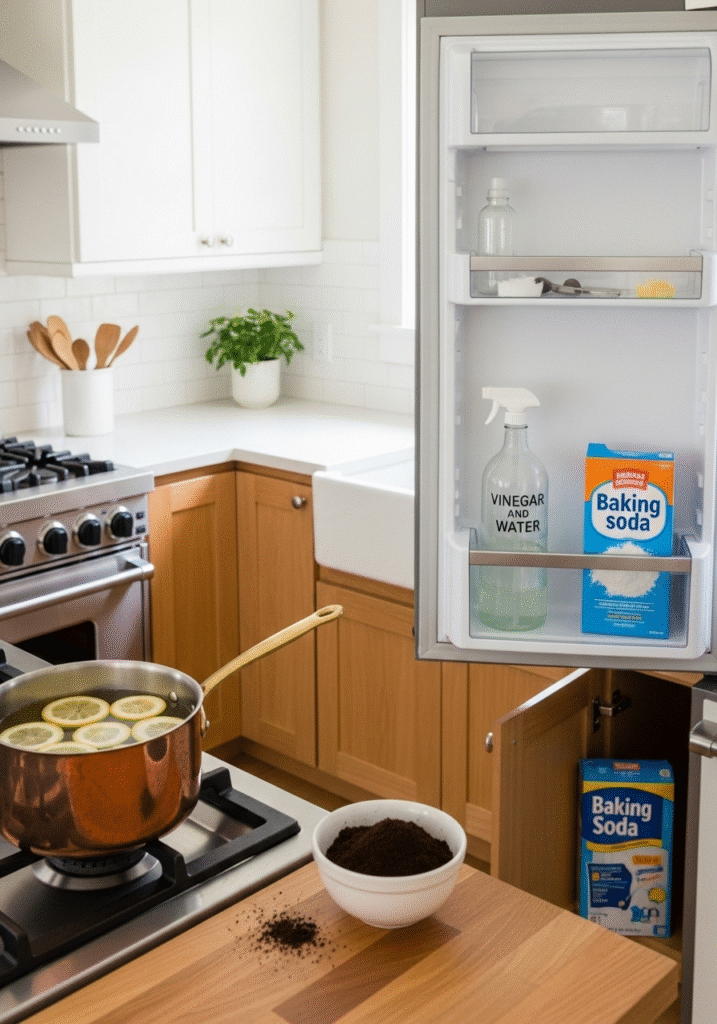
Bathroom Freshness the Natural Way
The bathroom is one of the most frequently used areas of any home—and one of the quickest to develop unpleasant odors. High humidity, lack of ventilation, and constant moisture make it an ideal environment for bacteria, mildew, and mold, all of which contribute to stale or musty smells. While many people turn to artificial air fresheners to combat this, these often just mask odors and contain harmful chemicals that can irritate the skin, lungs, and environment.
Thankfully, there are natural and eco-friendly ways to keep your bathroom smelling clean and fresh, all without relying on synthetic products. Using common household ingredients and a few simple tricks, you can naturally deodorize, disinfect, and freshen your bathroom, creating a healthier and more pleasant space.
Clean Toilets and Tubs with Vinegar and Baking Soda
To maintain a fresh bathroom, it’s essential to clean surfaces regularly with natural, non-toxic agents. White vinegar and baking soda are a powerhouse duo when it comes to eliminating grime, killing bacteria, and neutralizing foul smells. Unlike bleach-based cleaners, they are safe, inexpensive, and environmentally friendly.
To clean the toilet:
- Pour 1 cup of baking soda into the toilet bowl.
- Follow it with 1–2 cups of white vinegar.
- Let the mixture fizz and sit for about 10–15 minutes.
- Scrub with a toilet brush and flush.
To clean the tub and sink:
- Sprinkle baking soda over the surface.
- Spray with white vinegar until it fizzes.
- Scrub with a sponge or brush and rinse thoroughly with warm water.
This combination removes soap scum, hard water stains, and bacteria while also eliminating odors at the source.
Place a Sachet of Dried Lavender or Eucalyptus Behind the Toilet
One of the easiest ways to keep your bathroom smelling pleasant is to introduce natural herbal scents. Dried herbs like lavender and eucalyptus not only smell wonderful but also have antimicrobial properties that help inhibit bacteria and mold growth.
How to use:
- Fill a small muslin or cotton bag with dried lavender flowers or eucalyptus leaves.
- Tie it shut with a ribbon or string.
- Place it discreetly behind the toilet, on a shelf, or in a drawer.
The gentle aroma from the herbs will continuously release a light fragrance, creating a spa-like atmosphere in your bathroom without any chemicals or sprays. Replace the contents every few weeks for the best results.
Add Essential Oils to the Toilet Paper Roll Tube
This simple trick is an effective and long-lasting way to subtly scent your bathroom. Essential oils provide natural fragrance and therapeutic benefits, and applying them directly to the toilet paper roll tube allows the scent to disperse every time the roll is used.
Instructions:
- Choose a favorite essential oil—such as lavender (calming), peppermint (energizing), lemon (refreshing), or eucalyptus (cleansing).
- Add 4–5 drops to the inside of the cardboard tube (not the paper itself).
- The scent will gradually release over time, keeping the space smelling nice with no effort.
You can reapply the oil when the scent fades or each time you replace the roll.
Install a Small Fan or Improve Airflow
Odors in the bathroom often linger due to poor ventilation. Humidity from showers and baths creates the perfect environment for mildew, mold, and bacteria to thrive. Without good airflow, even the cleanest bathroom can smell musty. Installing or using a small fan can drastically improve the air quality and prevent odors from building up.
Tips to improve ventilation:
- Use an exhaust fan during and after showers to remove moisture from the air.
- If no fan is installed, consider using a portable fan or leaving the door and windows open.
- Use moisture-absorbing products like bamboo charcoal bags or natural dehumidifiers (such as rock salt in a bowl).
A dry, well-ventilated bathroom stays fresher longer and reduces the need for constant odor control.
Bonus Natural Tips for Bathroom Freshness
The bathroom is one of the most frequently used areas of any home—and one of the quickest to develop unpleasant odors. High humidity, lack of ventilation, and constant moisture make it an ideal environment for bacteria, mildew, and mold, all of which contribute to stale or musty smells. While many people turn to artificial air fresheners to combat this, these often just mask odors and contain harmful chemicals that can irritate the skin, lungs, and environment.
Thankfully, there are natural and eco-friendly ways to keep your bathroom smelling clean and fresh, all without relying on synthetic products. Using common household ingredients and a few simple tricks, you can naturally deodorize, disinfect, and freshen your bathroom, creating a healthier and more pleasant space.
Clean Toilets and Tubs with Vinegar and Baking Soda
To maintain a fresh bathroom, it’s essential to clean surfaces regularly with natural, non-toxic agents. White vinegar and baking soda are a powerhouse duo when it comes to eliminating grime, killing bacteria, and neutralizing foul smells. Unlike bleach-based cleaners, they are safe, inexpensive, and environmentally friendly.
To clean the toilet:
- Pour 1 cup of baking soda into the toilet bowl.
- Follow it with 1–2 cups of white vinegar.
- Let the mixture fizz and sit for about 10–15 minutes.
- Scrub with a toilet brush and flush.
To clean the tub and sink:
- Sprinkle baking soda over the surface.
- Spray with white vinegar until it fizzes.
- Scrub with a sponge or brush and rinse thoroughly with warm water.
This combination removes soap scum, hard water stains, and bacteria while also eliminating odors at the source.
Place a Sachet of Dried Lavender or Eucalyptus Behind the Toilet
One of the easiest ways to keep your bathroom smelling pleasant is to introduce natural herbal scents. Dried herbs like lavender and eucalyptus not only smell wonderful but also have antimicrobial properties that help inhibit bacteria and mold growth.
How to use:
- Fill a small muslin or cotton bag with dried lavender flowers or eucalyptus leaves.
- Tie it shut with a ribbon or string.
- Place it discreetly behind the toilet, on a shelf, or in a drawer.
The gentle aroma from the herbs will continuously release a light fragrance, creating a spa-like atmosphere in your bathroom without any chemicals or sprays. Replace the contents every few weeks for the best results.
Add Essential Oils to the Toilet Paper Roll Tube
This simple trick is an effective and long-lasting way to subtly scent your bathroom. Essential oils provide natural fragrance and therapeutic benefits, and applying them directly to the toilet paper roll tube allows the scent to disperse every time the roll is used.
Instructions:
- Choose a favorite essential oil—such as lavender (calming), peppermint (energizing), lemon (refreshing), or eucalyptus (cleansing).
- Add 4–5 drops to the inside of the cardboard tube (not the paper itself).
- The scent will gradually release over time, keeping the space smelling nice with no effort.
You can reapply the oil when the scent fades or each time you replace the roll.
Install a Small Fan or Improve Airflow
Odors in the bathroom often linger due to poor ventilation. Humidity from showers and baths creates the perfect environment for mildew, mold, and bacteria to thrive. Without good airflow, even the cleanest bathroom can smell musty. Installing or using a small fan can drastically improve the air quality and prevent odors from building up.
Tips to improve ventilation:
- Use an exhaust fan during and after showers to remove moisture from the air.
- If no fan is installed, consider using a portable fan or leaving the door and windows open.
- Use moisture-absorbing products like bamboo charcoal bags or natural dehumidifiers (such as rock salt in a bowl).
A dry, well-ventilated bathroom stays fresher longer and reduces the need for constant odor control.
Bonus Natural Tips for Bathroom Freshness
- DIY Bathroom Spray: Mix 1 cup distilled water, 1 tablespoon witch hazel or vodka, and 10–15 drops of essential oil in a spray bottle. Use as a natural air freshener.
- Baking Soda Jar Deodorizer: Place a jar of baking soda mixed with essential oils on a shelf. Poke holes in the lid for ongoing freshness.
- Indoor Plants: Small, low-light plants like peace lilies or aloe vera can help purify the air and absorb humidity.
- Clean drains monthly: Pour baking soda followed by vinegar into your drains to clear clogs and eliminate hidden odors.
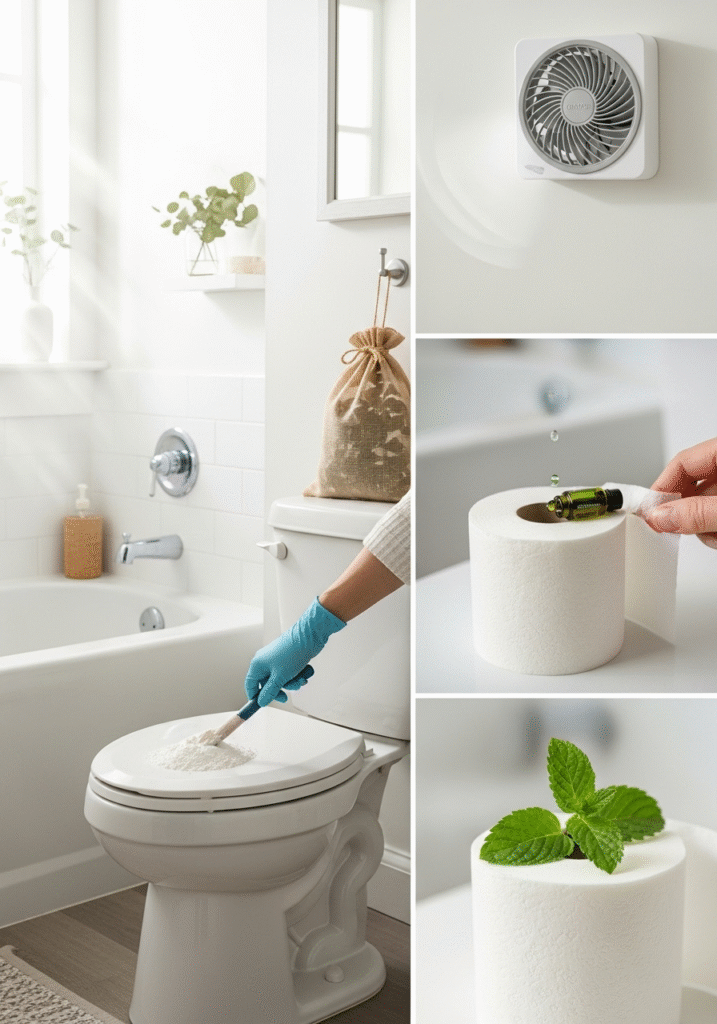
Smart Storage and Trash Management
An often-overlooked source of unpleasant odors in the home is improper storage and trash handling. From kitchen scraps and food packaging to bathroom waste and pet litter, the way we store and dispose of items plays a major role in maintaining a fresh-smelling environment. When waste is not managed properly, it can produce foul smells, attract pests, and contribute to indoor air pollution.
Implementing smart storage and trash management strategies not only keeps your home cleaner and more pleasant-smelling but also contributes to a more organized, sustainable lifestyle. Below are simple yet highly effective tips for minimizing odors and maintaining a hygienic space through natural and eco-friendly methods.
Use Sealed Containers for Food and Waste
One of the first lines of defense against household odors is proper containment. Food left uncovered or trash that is exposed can quickly lead to unpleasant smells, particularly in warm or humid environments. Using airtight, sealed containers helps trap odors and prevent them from spreading throughout your home.
For food storage:
- Store leftovers and perishable items in glass or BPA-free plastic containers with tight-fitting lids.
- Keep dry goods like grains, coffee, and spices in sealed jars to lock in freshness and prevent spills.
- Avoid keeping open food packaging in cabinets—transfer contents to resealable containers.
For waste management:
- Use lidded trash cans in kitchens, bathrooms, and bedrooms to contain odors.
- Choose trash bags that are sturdy and well-fitted to prevent leaks and overflows.
- For diapers or pet waste, use specially designed odor-locking containers or double-bag items before disposing.
Keeping containers closed and organized limits odor spread and helps maintain a cleaner atmosphere in every room.
Clean Trash Cans Weekly with Hot Water and Vinegar
Trash cans, especially in the kitchen, can become breeding grounds for bacteria and odor-causing residue. Even if you regularly change the bag, bits of waste or moisture can accumulate at the bottom or along the sides. Cleaning your bins weekly with natural disinfectants like white vinegar and hot water is an easy and non-toxic way to eliminate germs and smells.
How to clean your trash bin naturally:
- Empty the bin and remove the trash bag.
- Rinse with hot water to loosen debris.
- Fill with a mixture of 1 part white vinegar to 2 parts hot water.
- Let it sit for 10–15 minutes, then scrub with a brush or sponge.
- Rinse thoroughly and let it air dry in the sun if possible.
Vinegar naturally kills bacteria and neutralizes odors without harsh chemicals. For extra deodorizing, you can add a few drops of tea tree or lemon essential oil to the cleaning solution.
Sprinkle Baking Soda at the Bottom of Trash Bins
Baking soda is a powerhouse odor absorber that works wonders in trash cans. Sprinkling a generous layer of baking soda at the bottom of your bin can help absorb moisture and trap odors before they escape into your home.
How to use it:
- After cleaning the bin and before inserting a new trash bag, sprinkle 2–3 tablespoons of baking soda at the bottom.
- For ongoing freshness, replace the baking soda weekly or as needed.
- You can also add a few drops of lavender, eucalyptus, or lemon essential oil to the baking soda for a naturally pleasant scent.
This simple trick helps neutralize foul odors between deep cleanings and prevents trash smells from taking over your kitchen or bathroom.
Compost Organic Waste to Reduce Odor and Support Sustainability
One of the most effective ways to reduce trash-related odors is to divert organic waste—like food scraps, coffee grounds, and vegetable peels—into a compost system. Organic waste decomposing in sealed trash bags creates methane and strong odors. Composting not only eliminates this problem but also produces nutrient-rich soil for gardens and plants.
How to get started:
- Keep a small compost bin on your kitchen counter or under the sink with a tight-fitting lid.
- Line it with compostable bags or newspaper to keep it clean.
- Empty it regularly into an outdoor compost pile, compost tumbler, or municipal composting service (if available).
Common compostable items include:
- Fruit and vegetable scraps
- Coffee grounds and filters
- Eggshells
- Tea bags (unbleached)
- Shredded newspaper
Avoid composting meat, dairy, or oily foods indoors as they can attract pests and cause strong odors.
By composting, you reduce the volume of waste that goes into your main trash, eliminate much of the cause of household odors, and contribute to a more sustainable home.
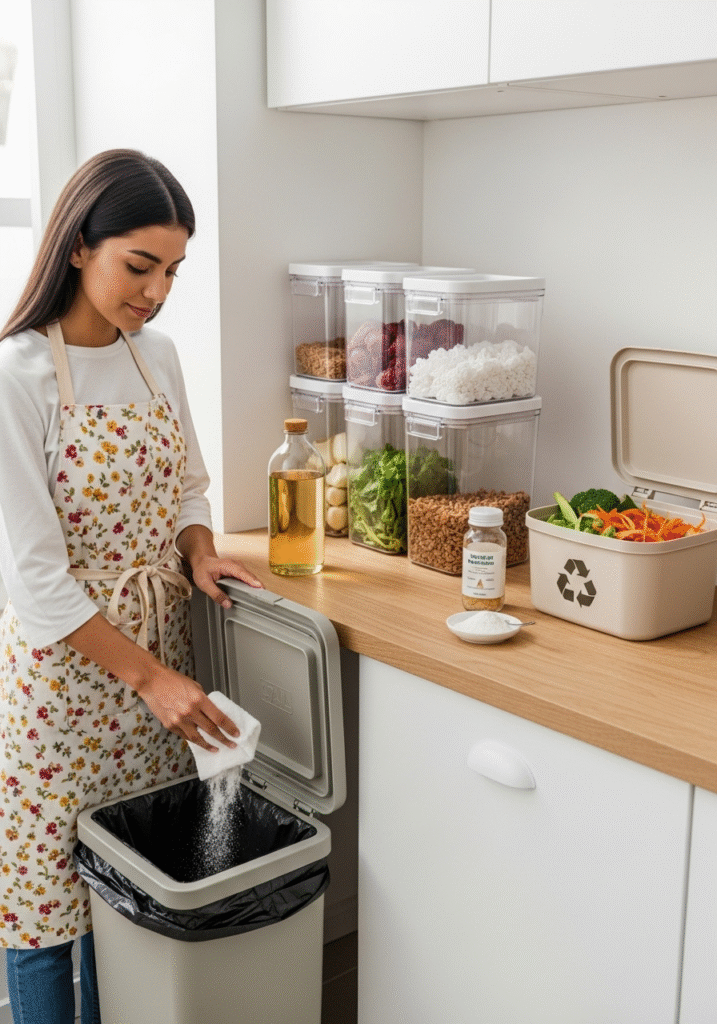
Seasonal Deep-Cleaning Routine
Maintaining a naturally fresh and clean-smelling home isn’t just about daily tidying—it requires a structured and consistent deep-cleaning routine. One of the most effective ways to stay on top of this is by implementing a seasonal (quarterly) cleaning schedule. This approach allows you to break down major tasks into manageable sections, focusing on the unique needs of your home as the seasons change.
Each season presents its own challenges and opportunities: pollen and dust in spring, increased activity in summer, cozy indoor time in fall, and sealed indoor air in winter. A seasonal deep-cleaning routine not only refreshes your home’s scent naturally but also improves indoor air quality, prevents odor buildup, and enhances the comfort and overall hygiene of your living space year-round.
Spring: Refresh and Air Out
Spring is synonymous with renewal, making it the perfect time to shake off winter’s stale air and accumulated dust. As nature blossoms, it’s also the ideal time to let in fresh air and clear out any allergens or grime that may have settled during the colder months.
Key tasks:
- Open windows wide to ventilate each room and bring in fresh air.
- Dust vents, fans, and ceiling corners, which tend to collect particles over the winter.
- Wash curtains, drapes, and window coverings to remove dust and odors.
- Clean windows and screens, allowing more natural light and improving air circulation.
- Declutter wardrobes and storage, donating or recycling unused items.
By tackling allergens and improving airflow, spring cleaning lays the foundation for a cleaner, fresher home environment.
Summer: Focus on Freshness and High-Traffic Areas
Summer often brings more guests, more movement in and out of the house, and more intense heat—all of which can contribute to stronger odors and faster buildup of grime. This season calls for a focus on deodorizing and cleaning the areas that experience the most wear.
Key tasks:
- Deep clean outdoor spaces like patios, balconies, grills, and doormats.
- Deodorize carpets and rugs using natural solutions like baking soda with essential oils, followed by vacuuming or steam cleaning.
- Clean and rotate couch cushions, especially in homes with pets or children.
- Scrub garbage bins and compost containers to prevent odor from summer heat.
- Maintain proper ventilation, especially in kitchens and bathrooms.
These efforts help keep your space fresh and odor-free during a season when odors tend to intensify.
Fall: Prepare for Cozy Indoor Living
As temperatures cool, we naturally spend more time indoors, making fall the right time to prepare your space for a cozy, clean environment. Fall deep cleaning should focus on revitalizing indoor areas and preparing for increased indoor air use.
Key tasks:
- Vacuum and steam-clean upholstered furniture to remove embedded odors and allergens.
- Clean light fixtures and ceiling fans, which collect dust and circulate it through the air.
- Dust and wipe down bookshelves, baseboards, and decorative surfaces.
- Clean and reorganize kitchen cabinets and pantries, discarding expired items.
- Wash bedding and bring out warmer linens, ensuring everything is fresh for the colder months.
A clean, well-prepared home allows you to enjoy the comforts of fall while maintaining a pleasant atmosphere indoors.
Winter: Sanitize and Refresh Core Living Spaces
Winter is the time when we seal our homes tightly to retain warmth, which can also trap odors. Since we spend so much time indoors during this season, it’s crucial to focus on air quality, comfort, and hygiene.
Key tasks:
- Organize and declutter storage areas, closets, and garages to start the new year fresh.
- Refresh mattresses and pillows by vacuuming and sprinkling baking soda with essential oils.
- Clean heating vents and filters, removing dust that could circulate through your home.
- Rotate and wash heavy blankets and winter bedding to eliminate musty smells.
- Wipe down walls and behind furniture, areas often neglected during routine cleaning.
By keeping your home clean and well-organized in winter, you’ll reduce stagnant air and maintain a warm, welcoming, and fresh-smelling environment.
Why a Seasonal Deep-Cleaning Routine Matters
Establishing a structured cleaning routine based on the seasons allows you to:
- Target areas most prone to seasonal dirt and odor.
- Maintain better indoor air quality.
- Reduce hidden sources of odors.
- Prevent dust, mold, and allergens from accumulating.
- Create a more peaceful, pleasant, and healthy home year-round.
With the help of natural cleaning ingredients—like vinegar, baking soda, lemon juice, and essential oils—you can tackle even the deepest cleaning tasks safely and effectively without using harsh chemicals.

Final Thoughts and Summary
Creating and maintaining a naturally fresh-smelling home is not only possible—it’s a rewarding lifestyle shift that benefits your health, your wallet, and the environment. While many people turn to commercial air fresheners and synthetic cleaning products to mask odors, these solutions are often temporary and can introduce harmful chemicals into your living space. Fortunately, by embracing natural methods, you can foster a truly clean, vibrant, and welcoming home without compromising your well-being.
Throughout this guide, we’ve explored simple yet effective strategies for eliminating odors at the source, enhancing indoor air quality, and infusing your space with refreshing, natural scents. From DIY air fresheners and linen sprays to the strategic placement of air-purifying plants and smart seasonal deep-cleaning, every approach offers a non-toxic alternative to commercial products—and most are surprisingly budget-friendly.
By identifying and addressing the root causes of odors—like poor ventilation, mold, trash buildup, or neglected fabrics—you can drastically reduce the need for cover-up scents. Adding fresh elements such as simmer pots, essential oil diffusers, or sachets of dried herbs brings a subtle, clean fragrance into your home that feels natural and calming.
Incorporating indoor plants not only elevates your décor but also actively cleans the air, improving both scent and air quality. Houseplants like peace lilies, spider plants, and English ivy are easy to maintain and help remove pollutants and musty odors from your living space. At the same time, routine cleaning with natural ingredients—such as vinegar, baking soda, and lemon—keeps surfaces and fabrics odor-free without the risk of chemical exposure.
Establishing habits like quarterly deep cleans, regular trash bin sanitization, and proper fabric care ensures that your home stays consistently fresh, no matter the season. Even small steps—like adding essential oils to your mop water or placing baking soda in the refrigerator—can have a big impact over time.
Start Small, Stay Consistent
Transitioning to a naturally fresh home doesn’t require a complete overhaul overnight. Start small by choosing one area of your home—like the kitchen or bathroom—and replace a commercial air freshener or cleaner with a homemade or natural alternative. Gradually expand to other rooms and practices. This steady, mindful approach makes the process manageable and helps you find what works best for your household.
Over time, these eco-conscious habits will become second nature, and you’ll begin to notice a real difference—not only in how your home smells but in how it feels. Cleaner air, fewer irritants, and a more serene, toxin-free environment can contribute to better sleep, improved mood, and overall well-being.
In Summary: Key Takeaways
- Identify and eliminate odor sources before adding scent.
- Use natural deodorizing ingredients like baking soda, vinegar, and lemon.
- Make DIY air fresheners, linen sprays, and simmer pots to add gentle fragrance.
- Add houseplants that naturally purify the air.
- Create a seasonal deep-cleaning routine to tackle hidden grime and lingering smells.
- Replace synthetic products gradually to minimize overwhelm and maximize results.
